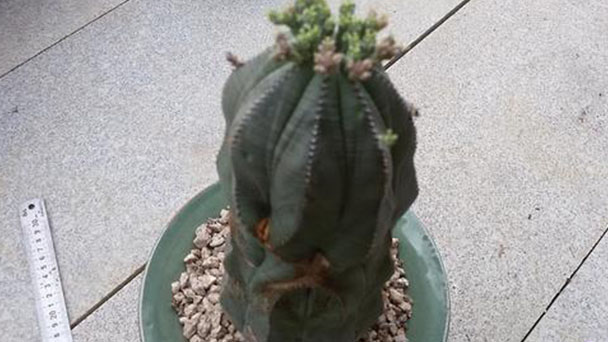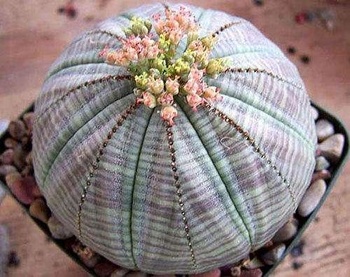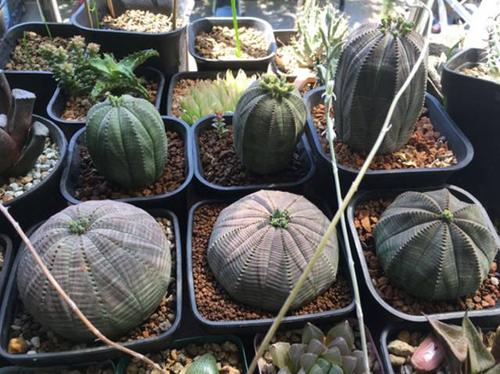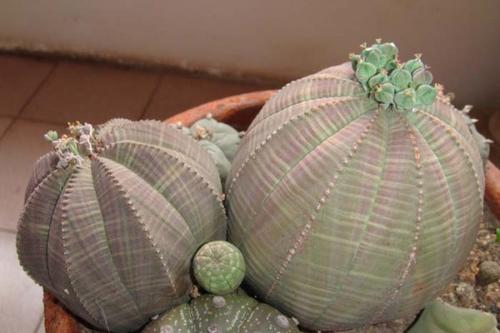How to care for Euphorbia obesa
Written by Maggie
Oct 13 2021

Euphorbia obesa is very rare and difficult to grow. So how to care for Euphorbia obesa when growing Euphorbia obesa? Here are some caring tips of growing Euphorbia obesa.

How to care for Euphorbia obesa not taking roots
To root Euphorbia obesa, you need to select loose, breathable, and fertile soil before sowing. During planting, put gravel in the bottom of the flowerpot to increase the breathability of the soil. This prevents poor growth of the Euphorbia obesa seed. A moderate amount of root powder can be added to the soil to encourage rooting in Euphorbia obesa, which is conducive to rapid rooting in the late period of Euphorbia obesa.
To grow roots quickly, you can use loose, fertile, nutrient-rich soil. Before planting, choose a flowerpot that is breathable and top the pot with gravel or non-woven fabric. Plant the soil in a pot and sow in euphorbia obesa in loose, airy, fertile soil to encourage rooting in Euphorbia obesa.
Root powder is a growth regulator for plants. During sowing, a moderate amount of root powder can be added to the soil to encourage rooting with Euphorbia obesa. During sowing, the root powder and soil can be mixed well. Plant the seeds in loose, airy soil. Rational maintenance of Euphorbia obesa will encourage Euphorbia obesa rooting.
After planting, to grow roots quickly, the Euphorbia obesa needs to control both moisture and ambient temperature. After sowing, keep the soil moist and ensure that the Euphorbia obesa seed is well watered and growing properly. During maintenance, keep the ambient temperature steady between 25 and 35 degrees so that the Euphorbia obesa grows rapidly.
The Euphorbia obesa needed plenty of light, water and fertilizer when it took root later. During maintenance, water the Euphorbia obesa area in moderation and place it in a sunny area. During maintenance, keep the soil moist and apply fertilizer over Euphorbia obesa. Attention should be paid to control the concentration of fertilizer during fertilization to avoid damage to the roots.
To prevent the Euphorbia obesa from growing, give it plenty of light during its growth. During maintenance, use Euphorbia obesa in an outdoor environment with good light. During maintenance, water and fertilizer use Euphorbia obesa in moderate amounts. Normal growth of Euphorbia obesa can be prevented from growing exclusively at the top of the late period.

How to care for Euphorbia obesa hypergrowth
During the growth period, the phenomenon of hypergrowth appeared mainly due to lack of light. To prevent growth of Euphorbia obesa, do not keep Euphorbia obesa in a shaded room for long periods of time during maintenance. During its growth, it can be placed outdoors in a sunny environment to give it plenty of light so that the top of Euphorbia obesa does not grow too long.
During maintenance, proper watering and fertilizing of Euphorbia obesa can also prevent the use of Euphorbia obesa in obesities. During growth period, frequently watering and fertilizing the flower with excessive water and nutrients causes the Euphorbia obesa to grow rapidly, resulting in the tip growing empty. During maintenance, control the amount of watering and applying fertilizer so that the word Euphorbia obesa grows normally.
Note that Euphorbia obesa is intolerant of bright light and needs shade during summer. During summer, to avoid the midday glare, move it outside to get more light when the light is weak in the morning or afternoon. This can prevent the Euphorbia obesa from growing too long. During the winter, it can be put on the indoor balcony to maintain.
During the growth period, the Euphorbia obesa needs a good growing environment. During maintenance, grow Euphorbia obesa in a warm, dry and well-ventilated environment. During the period of its growth, keep indoor air circulating so that the Euphorbia obesa soundscape can be grown normally. This can prevent the outbreak of pathogens or insects in the late period of the period.

Latest Updated
- Benefits of Bugleweed - 7 Science-backed Health Benefits
- Bugleweed Dangers & Side Effects - Is It Poisonous?
- How to Plant Evergreen Trees - What You Should Know
- When to Plant Evergreens - Grow Guide for Evergreen Trees
- 12 Wonderful Evergreen Shrubs for Your Garden
- 12 Popular Evergreen Plants with Pictures for Beginners
- When And How To Prune A Lilac Bush Like a Pro
- How to Grow & Care for Lilac Vine (Hardenbergia Violacea)
- Japanese Lilac Tree (Syringa Reticulata) Care & Propagation Guide
- Shumard Oak Pros and Cons - What to Know
Popular Articles
- Winter maintenance of Antirrhinum Majus
- How to Grow Terminalia Mantaly Tree
- How to Grow and Care for Crossostephium Chinense
- How to grow Antirrhinum Majus in spring
- Peristeria Elata (Dove Orchid) Profile: Info & Care Guide
- Underwatered Snake Plant (Sansevieria Trifasciata) - Signs And How To Fix
- How to Care for Brazilian Jasmine Plant (Mandevilla Sanderi)
- How to Grow & Care for Graptopetalum Purple Delight in Summer
- Rosa Chinensis (China Rose): Plant Growing & Care Tips
- How to Care for Baby Sun Rose (Aptenia Cordifolia)